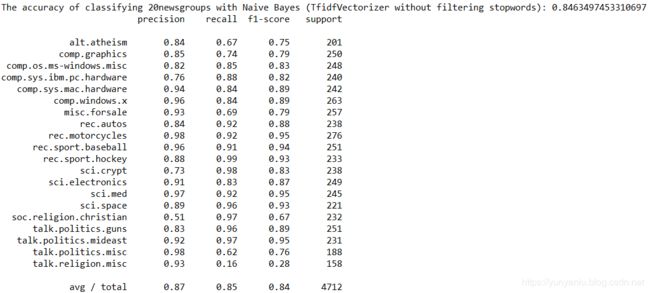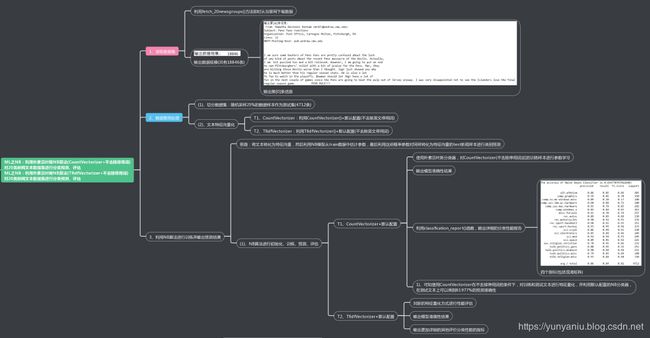ML之NB:利用朴素贝叶斯NB算法(TfidfVectorizer+不去除停用词)对20类新闻文本数据集进行分类预测、评估
ML之NB:利用朴素贝叶斯NB算法(TfidfVectorizer+不去除停用词)对20类新闻文本数据集进行分类预测、评估
目录
输出结果
设计思路
核心代码
输出结果
设计思路
核心代码
class TfidfVectorizer Found at: sklearn.feature_extraction.text
class TfidfVectorizer(CountVectorizer):
"""Convert a collection of raw documents to a matrix of TF-IDF features.
Equivalent to CountVectorizer followed by TfidfTransformer.
Read more in the :ref:`User Guide `.
Parameters
----------
input : string {'filename', 'file', 'content'}
If 'filename', the sequence passed as an argument to fit is
expected to be a list of filenames that need reading to fetch
the raw content to analyze.
If 'file', the sequence items must have a 'read' method (file-like
object) that is called to fetch the bytes in memory.
Otherwise the input is expected to be the sequence strings or
bytes items are expected to be analyzed directly.
encoding : string, 'utf-8' by default.
If bytes or files are given to analyze, this encoding is used to
decode.
decode_error : {'strict', 'ignore', 'replace'}
Instruction on what to do if a byte sequence is given to analyze that
contains characters not of the given `encoding`. By default, it is
'strict', meaning that a UnicodeDecodeError will be raised. Other
values are 'ignore' and 'replace'.
strip_accents : {'ascii', 'unicode', None}
Remove accents during the preprocessing step.
'ascii' is a fast method that only works on characters that have
an direct ASCII mapping.
'unicode' is a slightly slower method that works on any characters.
None (default) does nothing.
analyzer : string, {'word', 'char'} or callable
Whether the feature should be made of word or character n-grams.
If a callable is passed it is used to extract the sequence of features
out of the raw, unprocessed input.
preprocessor : callable or None (default)
Override the preprocessing (string transformation) stage while
preserving the tokenizing and n-grams generation steps.
tokenizer : callable or None (default)
Override the string tokenization step while preserving the
preprocessing and n-grams generation steps.
Only applies if ``analyzer == 'word'``.
ngram_range : tuple (min_n, max_n)
The lower and upper boundary of the range of n-values for different
n-grams to be extracted. All values of n such that min_n <= n <= max_n
will be used.
stop_words : string {'english'}, list, or None (default)
If a string, it is passed to _check_stop_list and the appropriate stop
list is returned. 'english' is currently the only supported string
value.
If a list, that list is assumed to contain stop words, all of which
will be removed from the resulting tokens.
Only applies if ``analyzer == 'word'``.
If None, no stop words will be used. max_df can be set to a value
in the range [0.7, 1.0) to automatically detect and filter stop
words based on intra corpus document frequency of terms.
lowercase : boolean, default True
Convert all characters to lowercase before tokenizing.
token_pattern : string
Regular expression denoting what constitutes a "token", only used
if ``analyzer == 'word'``. The default regexp selects tokens of 2
or more alphanumeric characters (punctuation is completely ignored
and always treated as a token separator).
max_df : float in range [0.0, 1.0] or int, default=1.0
When building the vocabulary ignore terms that have a document
frequency strictly higher than the given threshold (corpus-specific
stop words).
If float, the parameter represents a proportion of documents, integer
absolute counts.
This parameter is ignored if vocabulary is not None.
min_df : float in range [0.0, 1.0] or int, default=1
When building the vocabulary ignore terms that have a document
frequency strictly lower than the given threshold. This value is also
called cut-off in the literature.
If float, the parameter represents a proportion of documents, integer
absolute counts.
This parameter is ignored if vocabulary is not None.
max_features : int or None, default=None
If not None, build a vocabulary that only consider the top
max_features ordered by term frequency across the corpus.
This parameter is ignored if vocabulary is not None.
vocabulary : Mapping or iterable, optional
Either a Mapping (e.g., a dict) where keys are terms and values are
indices in the feature matrix, or an iterable over terms. If not
given, a vocabulary is determined from the input documents.
binary : boolean, default=False
If True, all non-zero term counts are set to 1. This does not mean
outputs will have only 0/1 values, only that the tf term in tf-idf
is binary. (Set idf and normalization to False to get 0/1 outputs.)
dtype : type, optional
Type of the matrix returned by fit_transform() or transform().
norm : 'l1', 'l2' or None, optional
Norm used to normalize term vectors. None for no normalization.
use_idf : boolean, default=True
Enable inverse-document-frequency reweighting.
smooth_idf : boolean, default=True
Smooth idf weights by adding one to document frequencies, as if an
extra document was seen containing every term in the collection
exactly once. Prevents zero divisions.
sublinear_tf : boolean, default=False
Apply sublinear tf scaling, i.e. replace tf with 1 + log(tf).
Attributes
----------
vocabulary_ : dict
A mapping of terms to feature indices.
idf_ : array, shape = [n_features], or None
The learned idf vector (global term weights)
when ``use_idf`` is set to True, None otherwise.
stop_words_ : set
Terms that were ignored because they either:
- occurred in too many documents (`max_df`)
- occurred in too few documents (`min_df`)
- were cut off by feature selection (`max_features`).
This is only available if no vocabulary was given.
See also
--------
CountVectorizer
Tokenize the documents and count the occurrences of token and
return
them as a sparse matrix
TfidfTransformer
Apply Term Frequency Inverse Document Frequency normalization to a
sparse matrix of occurrence counts.
Notes
-----
The ``stop_words_`` attribute can get large and increase the model size
when pickling. This attribute is provided only for introspection and can
be safely removed using delattr or set to None before pickling.
"""
def __init__(self, input='content', encoding='utf-8',
decode_error='strict', strip_accents=None, lowercase=True,
preprocessor=None, tokenizer=None, analyzer='word',
stop_words=None, token_pattern=r"(?u)\b\w\w+\b",
ngram_range=(1, 1), max_df=1.0, min_df=1,
max_features=None, vocabulary=None, binary=False,
dtype=np.int64, norm='l2', use_idf=True, smooth_idf=True,
sublinear_tf=False):
super(TfidfVectorizer, self).__init__(input=input, encoding=encoding,
decode_error=decode_error, strip_accents=strip_accents,
lowercase=lowercase, preprocessor=preprocessor, tokenizer=tokenizer,
analyzer=analyzer, stop_words=stop_words,
token_pattern=token_pattern, ngram_range=ngram_range,
max_df=max_df, min_df=min_df, max_features=max_features,
vocabulary=vocabulary, binary=binary, dtype=dtype)
self._tfidf = TfidfTransformer(norm=norm, use_idf=use_idf,
smooth_idf=smooth_idf,
sublinear_tf=sublinear_tf)
# Broadcast the TF-IDF parameters to the underlying transformer
instance
# for easy grid search and repr
@property
def norm(self):
return self._tfidf.norm
@norm.setter
def norm(self, value):
self._tfidf.norm = value
@property
def use_idf(self):
return self._tfidf.use_idf
@use_idf.setter
def use_idf(self, value):
self._tfidf.use_idf = value
@property
def smooth_idf(self):
return self._tfidf.smooth_idf
@smooth_idf.setter
def smooth_idf(self, value):
self._tfidf.smooth_idf = value
@property
def sublinear_tf(self):
return self._tfidf.sublinear_tf
@sublinear_tf.setter
def sublinear_tf(self, value):
self._tfidf.sublinear_tf = value
@property
def idf_(self):
return self._tfidf.idf_
def fit(self, raw_documents, y=None):
"""Learn vocabulary and idf from training set.
Parameters
----------
raw_documents : iterable
an iterable which yields either str, unicode or file objects
Returns
-------
self : TfidfVectorizer
"""
X = super(TfidfVectorizer, self).fit_transform(raw_documents)
self._tfidf.fit(X)
return self
def fit_transform(self, raw_documents, y=None):
"""Learn vocabulary and idf, return term-document matrix.
This is equivalent to fit followed by transform, but more efficiently
implemented.
Parameters
----------
raw_documents : iterable
an iterable which yields either str, unicode or file objects
Returns
-------
X : sparse matrix, [n_samples, n_features]
Tf-idf-weighted document-term matrix.
"""
X = super(TfidfVectorizer, self).fit_transform(raw_documents)
self._tfidf.fit(X)
# X is already a transformed view of raw_documents so
# we set copy to False
return self._tfidf.transform(X, copy=False)
def transform(self, raw_documents, copy=True):
"""Transform documents to document-term matrix.
Uses the vocabulary and document frequencies (df) learned by fit (or
fit_transform).
Parameters
----------
raw_documents : iterable
an iterable which yields either str, unicode or file objects
copy : boolean, default True
Whether to copy X and operate on the copy or perform in-place
operations.
Returns
-------
X : sparse matrix, [n_samples, n_features]
Tf-idf-weighted document-term matrix.
"""
check_is_fitted(self, '_tfidf', 'The tfidf vector is not fitted')
X = super(TfidfVectorizer, self).transform(raw_documents)
return self._tfidf.transform(X, copy=False)

